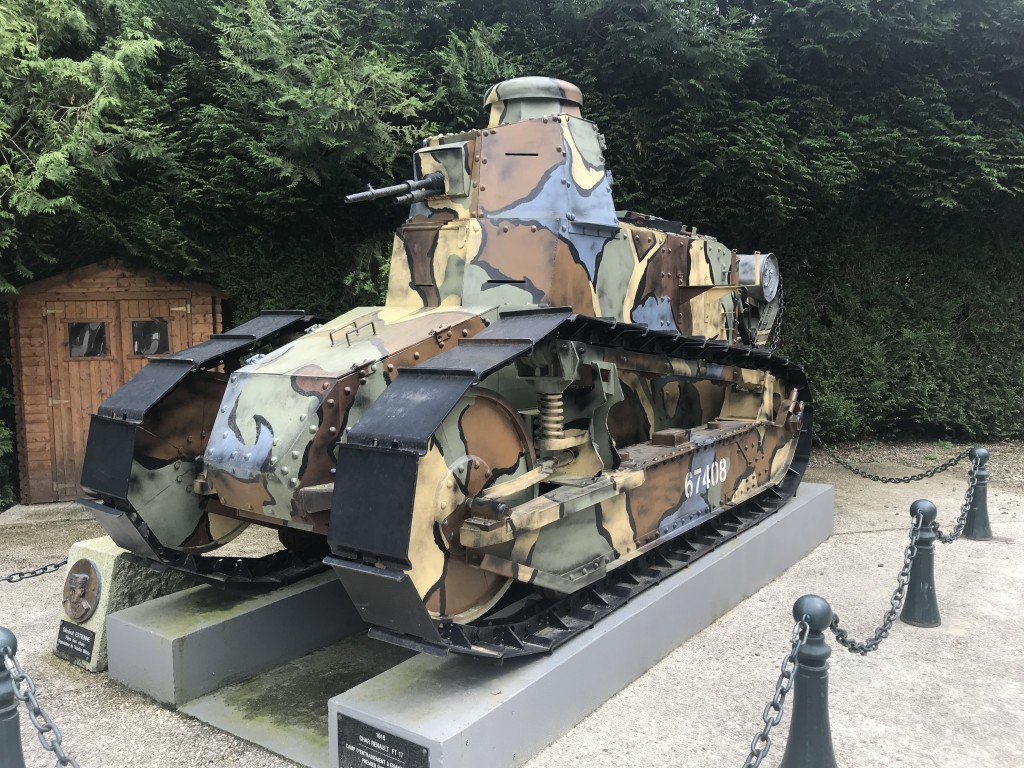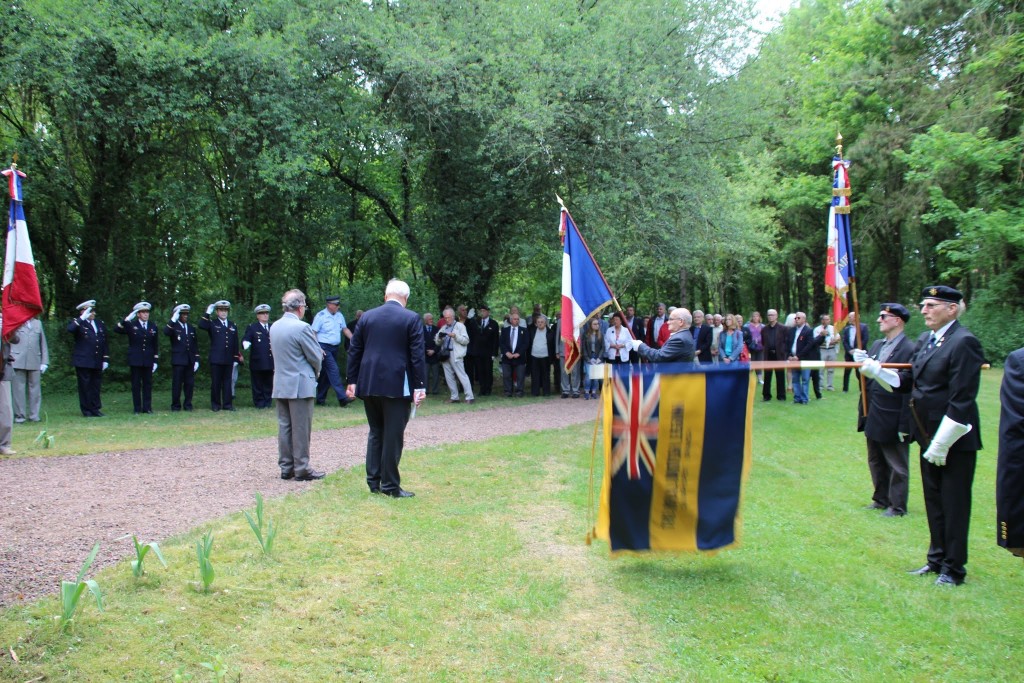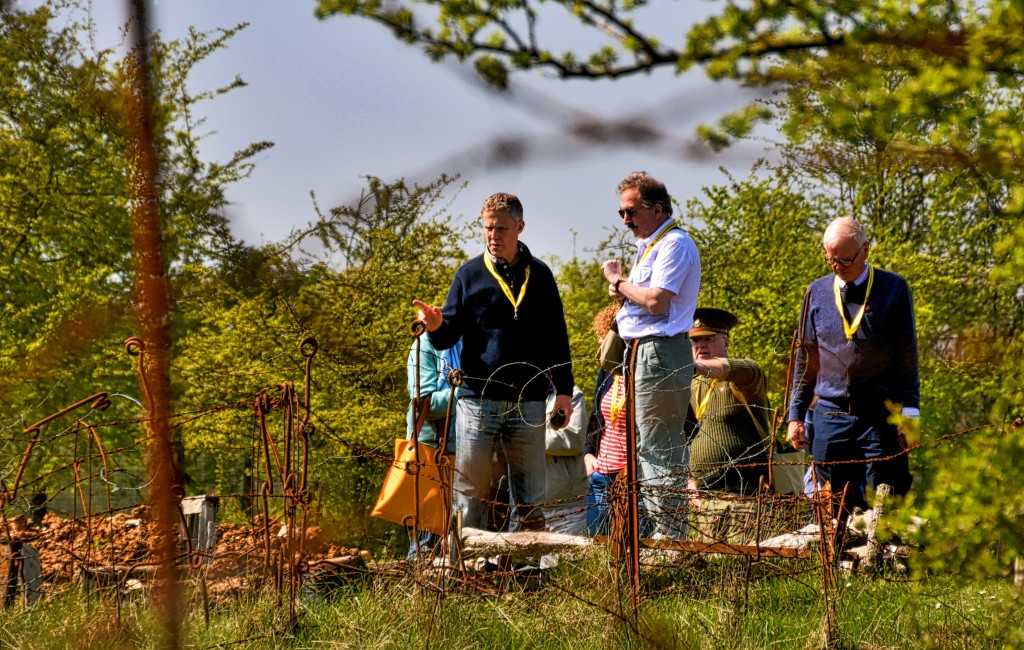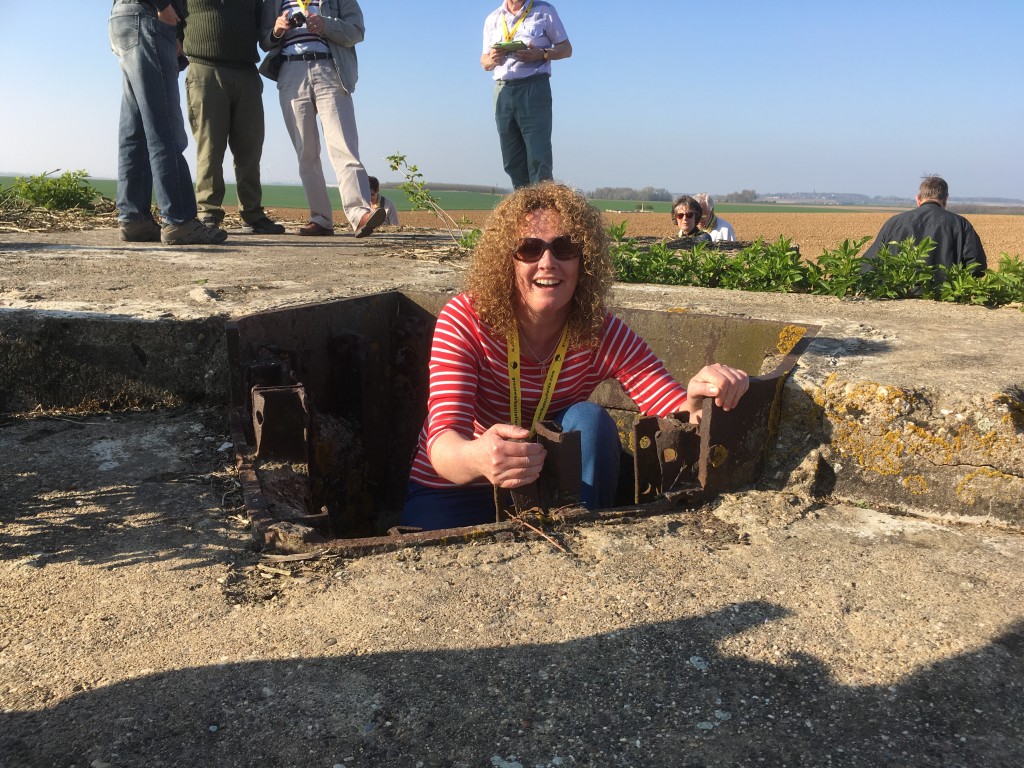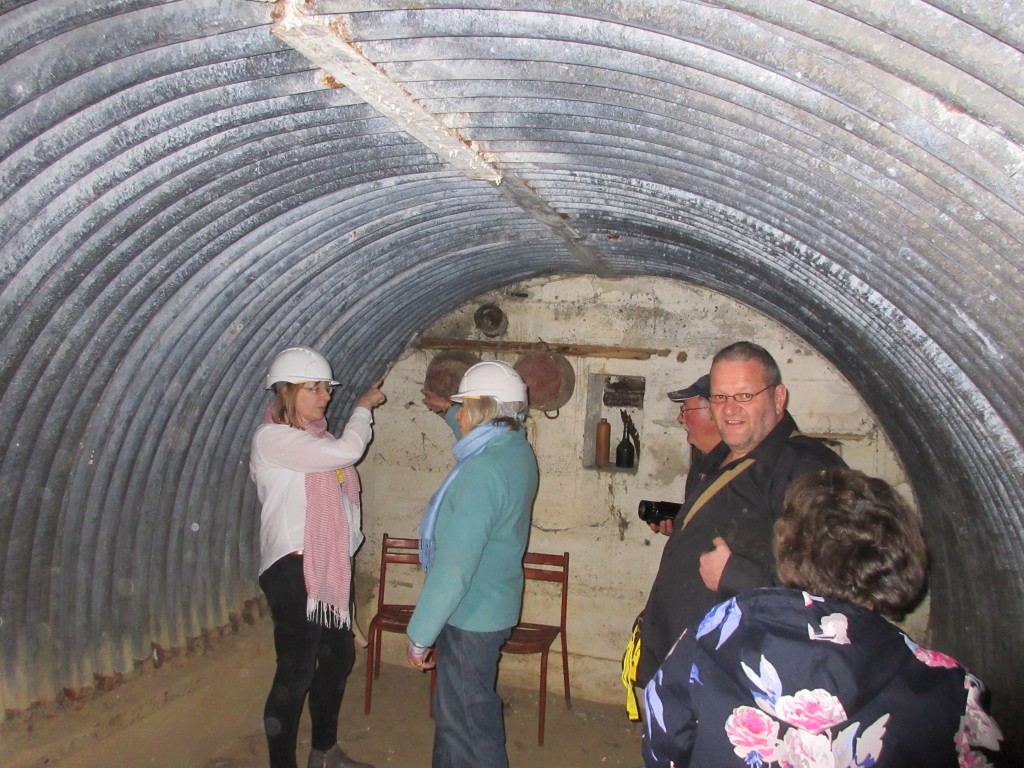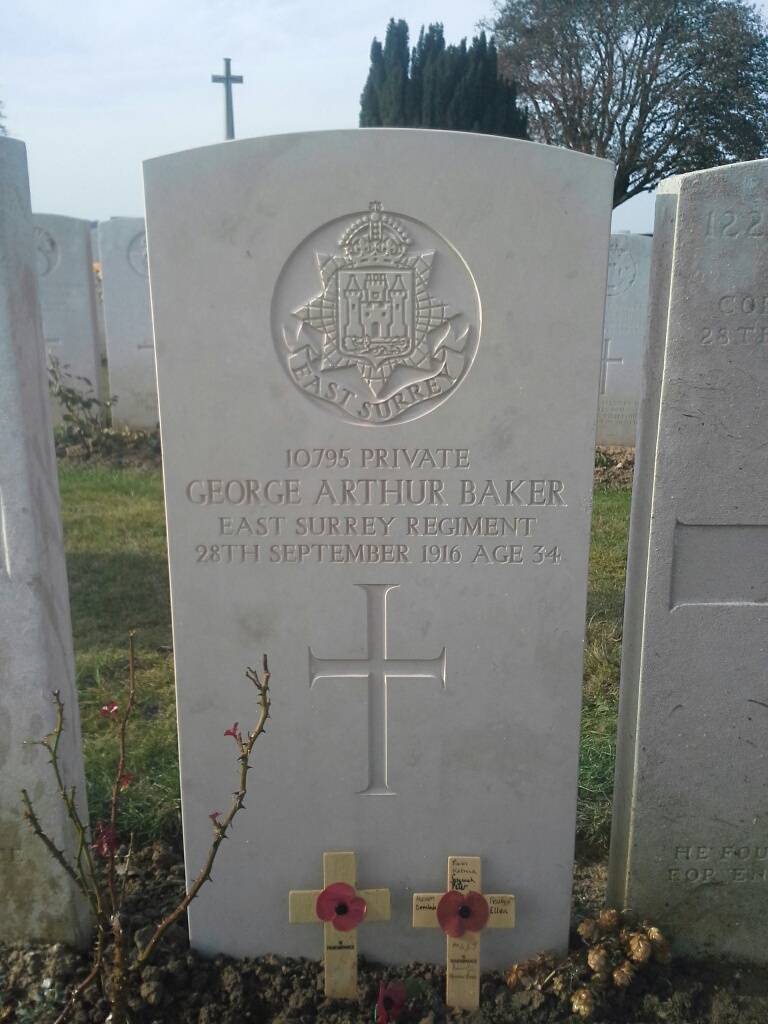Advance to Victory
Continuing Great War Battlefields’ theme of tracking the war in its exact centenary years, there was no getting away from the fact that 1918 was different: after nearly four years of stalemate in the trenches, the final 100 days of the Great War saw dramatic movements to and fro across the devastated Western Front. This tour therefore involved more travelling than previous ones: primarily it followed in the steps of the Allies’ Advance to Victory, but the area thus covered also gave ideal opportunities to visit sites relevant to the Germans’ do-or-die offensive from the spring of 1918, and also scenes from way back in 1914 when the opposing armies had fought their way across the self-same ground. The tour included scenes of major battles and of specific actions where Victoria Crosses were won, and covered the involvement of famous individuals, of many nations – Great Britain, Canada, Australia, New Zealand, France, the USA and Germany – and of our local regiments from Kent and Sussex.
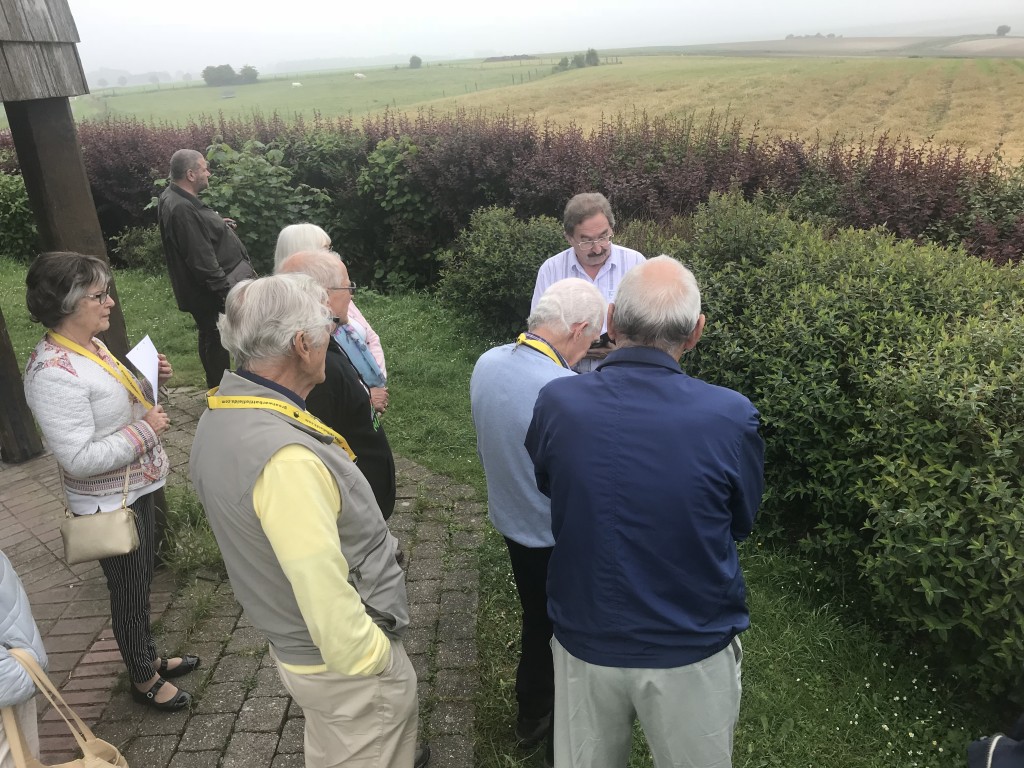 After our customary Channel crossing via Eurotunnel, we paused on the way south to view the site of the Battle of Creçy (1346) – several centuries adrift from our normal period of interest, but close enough to our route to merit a visit. An early lunch was enjoyed at the café on the square in Saint-Riquier, a village positively overflowing with history, and shortly afterwards we reached the area east of Amiens where the Germans’ 1918 spring offensive was stemmed and where the tide was conclusively turned against them in August of that year. Scenes from the spring battles were described in the fields where Lieutenant Gordon Flowerdew won a VC for leading an almost suicidal – but decisive – charge by the Canadian cavalry, and then only a mile away where the first ever tank v. tank battle had taken place barely three weeks later.
After our customary Channel crossing via Eurotunnel, we paused on the way south to view the site of the Battle of Creçy (1346) – several centuries adrift from our normal period of interest, but close enough to our route to merit a visit. An early lunch was enjoyed at the café on the square in Saint-Riquier, a village positively overflowing with history, and shortly afterwards we reached the area east of Amiens where the Germans’ 1918 spring offensive was stemmed and where the tide was conclusively turned against them in August of that year. Scenes from the spring battles were described in the fields where Lieutenant Gordon Flowerdew won a VC for leading an almost suicidal – but decisive – charge by the Canadian cavalry, and then only a mile away where the first ever tank v. tank battle had taken place barely three weeks later.
We moved on to consider the Australian contribution to the war at their spectacular national memorial outside Villers-Bretonneux, beneath which a brand-new visitor centre offers an absorbing exhibition. The weather by now had become hot and sunny, providing superb views for those with the energy to climb to the top of the memorial tower. Moving on eastwards in the track of the Advance to Victory, we halted at the site of the Red Baron’s fatal fall from the skies, and then spent a while at Beacon Cemetery near which Thomas Harris of the Royal West Kent Regiment had won the VC on the first day of that advance, and where one of our number provided a moving personal account of a soldier ancestor who is buried there.
Dinner on the grand square at Saint-Quentin was followed by the first of our two nights at the comfortable new Ibis hotel facing the medieval cathedral.
A deluge during the night was witnessed by few of us, but its effects were plain to see as soon as we left the town next morning: plentiful mud (the essential accompaniment to every good Great War story) had been washed off the fields and onto the country roads. We paused first at “Cookers Quarry” where the grandfather of one of our number is known to have been in action on the first day of the Germans’ spring offensive, and then a mile away at “Shepherds Copse” for the story of John Sayer of the Royal West Surreys winning his VC on the same day. Our visit to the American military cemetery at Bony was somewhat restricted due to their making urgent preparations for high-ranking visitors arriving later on for Veterans’ Day ceremonies, but we were more than compensated by the meticulous displays of colourful flags and wreaths laid on for the occasion.
The story of the Advance to Victory was specifically resumed at the nearby village of Lempire, recounting the Buffs’ action there in mid-September, and the war experiences of George Poile from Goudhurst who was killed a few days later and is buried in Unicorn Cemetery. Le Catelet provided a welcome mid-morning drink and a remarkable reference back to the 1914 Retreat from Mons and the tragic consequences for four of its Old Contemptible participants. Next for consideration came some of the actions of late September 1918, notably where the Hindenburg Line was breached thanks to the heroic crossing of the Saint-Quentin Canal by British, American and Australian forces. These events were explained at three distinct locations: the spot where the canal enters a 3-mile long tunnel, the bridge at Riqueval, and the American memorial.
After a picnic lunch in some welcome shade, we drove down to Compiègne to visit the glade where the Armistice was signed on 11th November 1918 (and where Hitler took his revenge in 1940 by exacting the surrender of France). Back at Saint-Quentin, there was time for a relaxing stroll and a drink before dinner in the square.
one of the more remarkable ones on the Western Front, being the last resting-place of men and women of many nationalities from the beginning to the end of the Great War. Our final halt, a few miles further on, was at Le Qusenoy, captured by New Zealanders who scaled its me
Day 3 began with tales of events in Saint-Quentin itself, and we then resumed our eastward advance. Some of the many significant actions of 4th November in particular were examined on site, notably the crossing of the Sambre-Oise Canal at Bois de l’Abbaye by men of the Royal Sussex Regiment, and nearby at Ors by men of the Manchester Regiment, among them Wilfred Owen who was killed in that day’s fighting and whose grave we visited. Reminders of 1914 re-surfaced during the day, since we (and the troops of 1918) were proceeding along precisely the same roads – but happily in the opposite direction – which had witnessed the punishing Retreat from Mons.
After an excellent lunch in the historic brewery at Le Cateau, there was time for reflection in the military cemetery overlooking the fields where the British Army, during the Retreat from Mons, had memorably paused to give the Germans a bloody nose. The cemetery is dieval ramparts in truly medieval fashion!
All in all, an opportunity to visit a range of lesser known locations providing some fascinating stories from decisive phases of the Great War.
Poelcapelle – 8th & 9th October 2017
Our latest tour to the 1914-18 battlefields of the Western Front, on 8th/9th October 2017, can truly be described as unrepeatable, since it included a once-in-a-lifetime event, plus access to a location due to be permanently sealed up in November 2017.
About a year ago we had the good fortune to befriend a young enthusiast, Stijn Butaye, living between Ypres and Passchendaele, who has developed his own impressive Great War museum based on material found on his farm property: see www.pondfarm.be Beyond that, however, he and a team of friends have been building a full-size working replica of a British Mk. IV tank with a view to using it – in various incarnations – to re-enact famous moments from the early days of tanks. Its first public appearance, in a field near Pond Farm from 22nd to 24th August 2017, was as “Fray Bentos” (all tanks had nicknames) which got bogged down in an attack on 22nd August 1917, leaving its crew stranded in no man’s land for 72 hours. On Day 1 of the trip our group saw it re-launched as “Damon II” in a commemoration of the centenary of the Battle of Poelcapelle, a phase of the Third Battle of Ypres (better known as Passchendaele). We joined hundreds of other enthusiasts and a splendid pipe band in following the tank’s slow but sure advance along nearly two miles of public road into Poelcapelle, with frequent halts along the way to enjoy refreshments and listen to live music and readings of personal accounts written by members of the tank crews involved back in 1917. We congratulate the tank team and their scores of supporting volunteers for producing such an impressive, memorable and friendly occasion.
On Day 2 we were able to inspect a remarkable relic of the Ypres battlefields which has been resurrected recently but which will disappear forever in November: an extraordinarily well preserved dugout built by Canadian artillerymen in 1917/18 beneath the protective pile of rubble that had been Zonnebeke church. Formally re-opened by Prince Charles on 31st July 2017, its perfect state of preservation results from being waterlogged, and the only way to ensure its survival into the future is to flood it again and seal it up. We then visited the adjacent Passchendaele Memorial Museum which nowadays houses an excellent and very wide-ranging collection of Great War material and also features comparative examples of trench designs developed by the combattant nations as the war progressed.
Either side of these main features of the tour, we visited Lijssenthoek Military Cemetery and its visitor centre’s massive display of often surprising information about the pioneering medical facilities that dealt with 300,000 casualties there between 1914 and 1918, and a cluster of sites between Messines and Ploegsteert Wood recalling momentous events and people from that period: the 1914 Christmas truce, the simultaneous detonation of 19 British mines in June 1917, Adolf Hitler, Winston Churchill, the cartoonist Bruce Bairnsfather ……. and even William the Conqueror: as ever with Great War Battlefields, our travellers have come to expect the unexpected!
Proville Ceremony – Tuesday 30th May 2017
Speech given by Richard Dixon and Roger Joye
Written by Roger Joye
Our group came to Proville on 9th April intending to visit the bunkers at La Marlière, assisted by our new-found friends from the Local History Society in Proville. My colleague Peter and I had regarded the visit as a small part of a weekend dedicated to understanding the Battles of Arras and Cambrai which took place in 1917.
Our friends in Proville willingly gave us their expertise and enthusiasm during the visit to the bunkers, and then added a typically French measure of hospitality by inviting us to attend a reception in the beautiful Mairie, an invitation which we were delighted to accept. On the day of the visit, we learned that the invitation had been further extended to include a ceremony of remembrance in the British military cemetery of Proville, a perfectly organised event which we had not foreseen and which we found very moving. Proville was liberated by the British army on 9th October 1918, and the military cemetery containing 149 soldiers at the centre of the village is a constant reminder of the cost of that liberation.
On 10th October 1918, one of the soldiers from our own village in Kent gave his life during the liberation of Cagnoncles; we have just been there to see his grave and to honour his memory. That young man is of particular importance to us thanks to his nephew, born during the Second World War and who died six years ago. He tended the small garden around our war memorial and, one day about 20 years ago, he began to wonder about the story of this uncle whom he never knew. This inspired a long process of research into all 60 of our soldiers who died in the First World War: without that moment of inspiration, we would never have got so involved in the history of the war …… and we would not be here today.
On 9th April the people of Proville gave us a wonderful reception in the Mairie, and we heard for the first time the story of the RAF bomber which crashed here on 30th May 1943. We learned that 400 villagers attended the funeral of the five airmen, despite a German ban on any show of sympathy for the Allies. In 1948 the people of Proville created this unique monument to ensure that the memory of the crew would be perpetuated.
We cannot begin to tell you – especially in French – how much we have been moved by the warmth of your welcome, and even more by the respect and gratitude which the people of Proville have continued to show to the British soldiers and airmen who fought in this region during two World Wars. We had envisaged a short visit to a site of historical interest, but you gave us the most moving and memorable day among all our journeys to France.
We thank you most sincerely for the respect and care which you continue to show to all our servicemen in the last 100 years. On behalf of the families of the soldiers and airmen buried here, and of those who have no known grave, we thank you for ensuring that their sacrifice is not forgotten.
Vive la France! God save the Queen!
More photos in: Flickr
Arras & Cambrai, 8th – 9th April 2017
Great War Battlefields’ first overnight tour of 2017 – our first ever to the 1917 battlefields of Arras and Cambrai – was, like all our original tours, many months in the making. Indoor and outdoor museums, battlefield locations, monuments, cemeteries, soldiers’ personal stories: the usual mix of ingredients had been carefully considered, sifted, researched and inspected in detail and then fitted in among our choice of restaurants, hotels and travel arrangements aiming to provide an instructive, entertaining and thought-provoking itinerary for the weekend of 8th – 9th April.
The Battle of Arras had started in freezing conditions and snow on 9th April 1917, so our decision to run the tour on the exact centenary weekend was taken in the face of possible weather risks and also the certainty that there would be some road-blocks in the area to ensure security for various high-profile centenary events.
Arriving on time at Dover docks, we were promptly allocated a sailing one hour later than scheduled …… Never mind, after our first stop at Notre-Dame-de-Lorette to visit a remarkable little museum and adjacent preserved battlefield trenches and paraphernalia, we saved time by eating our baguettes en route to Arras instead of at picnic tables.
Next, a security barrier blocked our planned visit to the atmospheric Zivy Crater Cemetery, but we saved more time by going straight on to the Arras Memorial to the Missing where the Lyon family from Wales laid a wreath in memory of grandfather John Dunlavey, almost 100 years to the day since he and many of his comrades in 7/Border Regiment were lost in action in fields outside Monchy-le-Preux. We moved on a few miles to view those very fields and to gain an understanding of the fierce fighting which had taken place in the heart of the village, now so peaceful and enhanced by stylish memorials to the men of the Newfoundland Regiment and 37th Division.
Our final site visit on Day 1 was a hilltop bunker on the Hindenburg Line, offering a sweeping vista towards the old British front lines, not to mention an irresistible temptation for the more adventurous to dive inside.
Day 2 began with an overview of the Somme battlefield and a specific visit to the Tank Corps memorial at Pozières as an introduction to those innovative machines which were such a significant feature of the 1917 Battle of Cambrai. An explanation of the “big picture” of that battle was delivered while appreciating the panoramic view across the battlefield from Trescault, the central point of the stunning British advance of 20th November 1917. Following the line of the advance, we recounted – on site – the actions of Lance-Corporal Robert McBeath and Captain Richard Wain which won them the Victoria Cross on that day.
Careful planning by way of site meetings and correspondence over the last year with the local history society at Proville, on the outskirts of Cambrai, had promised a guided visit inside two bunkers which they have painstakingly rescued from the effects of 100 years of plant-life and flooding; with a fortnight to go, the invitation had suddenly been extended to include “a little reception at Proville town hall”. In the event, we were greeted at the bunkers by the top brass of the history society, the deputy mayor, a wildly enthusiastic reporter, an imposing-looking Colonel, a gendarme directing the traffic and several other bodies whom we never quite identified. The tour of the bunkers was conducted efficiently, enabling us to admire the enduring quality of German concrete and sheet metal, and we were then told that they would now take us to visit the nearest CWGC cemetery. Any minor concerns that our timetable was going off the rails were obliterated by finding the town’s silver band and all the dignitaries there, together with a small girl bearing a huge wreath to be laid at the central cross in a joint Anglo-French ceremony. The wreath was laid, the band played “God Save the Queen” (which we were too stunned and overcome to sing), the mayor made a speech and then incited the band to perform an encore so that we could sing properly second time round! And so to the town hall for a champagne reception, another speech by the mayor, our impromptu response in French, interviews on camera by the reporter, and a general outpouring of bonhomie…….. Just when we thought it was all over (and time for lunch), a figure emerged from the crowd with an invitation to view “Deborah”, a now famous Mk. IV British tank put out of action during the Battle of Cambrai, lovingly excavated almost 20 years ago, and shown to selected guests: we had tried negotiating for this more than a year before, direct with the owner, and latterly asked the local history society to put in a good word for us, all apparently to no avail – until now!
The novelty of a couscous lunch in an exquisite Moroccan setting in Cambrai added to the surreal atmosphere now surrounding the tour, which was completed with a thorough inspection of “Deborah” and finally the reading of a poem beside the grave of its author, Lieutenant Ewart Alan Mackintosh, killed in action on 21st November 1917.
Great War Battlefields is thinking of adopting “Expect The Unexpected” as its motto………..
George Baker’s Headstone Replaced after 100 Years
Luck, coincidence and diligent research all combined to replace the headstone on the war grave of Goudhurst man, George Baker, in Grove Town Cemetery at Méaulte, on the Somme in France one hundred years after his death. Private George Arthur Baker of the East Surrey Regiment died during the Battle of the Somme on 28th September 1916.
On 29th March of this year, Great War Battlefields of Goudhurst which specialises in organising visits to the cemeteries of the First World War in France and Belgium, arranged for a group of local people to attend a ceremony at the French cemetery to commemorate the renewal of George Baker’s headstone. In Goudhurst and Kilndown the local branch of the Royal British Legion and Great War Battlefields combine to fulfil a pledge to hold a short ceremony at their two War Memorials on the centenary of the deaths of the sixty six parishioners who gave their lives in WWI. The ceremony in France was a natural extension of their efforts to respect and pay tribute to one of their fallen.
Back in 2007 the late Bob Brown, then chairman of Goudhurst & Kilndown History Society, discovered that George Baker’s headstone showed his name as “Barer”. The Commonwealth War Graves Commission promised to re-engrave the name. When Goudhurst historian, Roger Joye, visited the grave in 2016 he found two surprises. First of all the “re-engraving” was far from satisfactory with a K being imposed over the R. But there was a wreath of poppies on the grave even though Roger and his wife Gill had researched and found no direct descendants.
The centenary of George Baker’s death was commemorated in Goudhurst and, as luck would have it, attended by George Jessel, the recently-appointed High Sheriff of Kent. When Peter Rolington of Great War Battlefields told him of the mystery and the state of the headstone, he immediately offered to contact the Commonwealth War Graves Commission to see what could be done to improve the engraving.
Unbeknown to all in Goudhurst at the time, on that same centenary day members of George Baker’s family visited the grave in France and planted two wooden crosses bearing their Christian names. In October the CWGC wrote to George Jessel to say they had installed a new headstone and enclosed a photograph – by coincidence and luck the two wooden crosses were included in the image and the names were legible.
Gill Joye immediately set about tracing the names and her diligent research constructed a family tree descending from George’s sister, Mary, and including several of the names on the crosses. It transpired that the poppy wreath Roger Joye had seen in 2016 had been laid by his 14 year-old great, great niece, Miriam Small, during a school visit.
During the Goudhurst visit to commemorate the renewal of George Baker’s headstone, George Jessel laid a poppy wreath. Similarly, Lt. Col. Tim Nicholson, acting chairman of the Goudhurst branch of the Royal British Legion, laid a poppy wreath depicting the East Surrey Regiment. The RBL standard, having obtained special permission from the British Legion, was paraded by Mick Harris and the last post was sounded.




